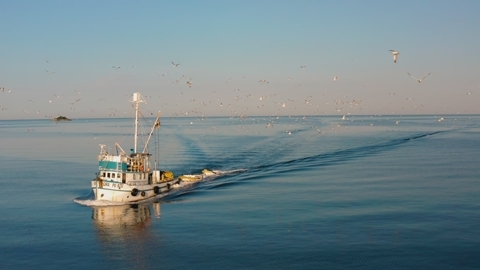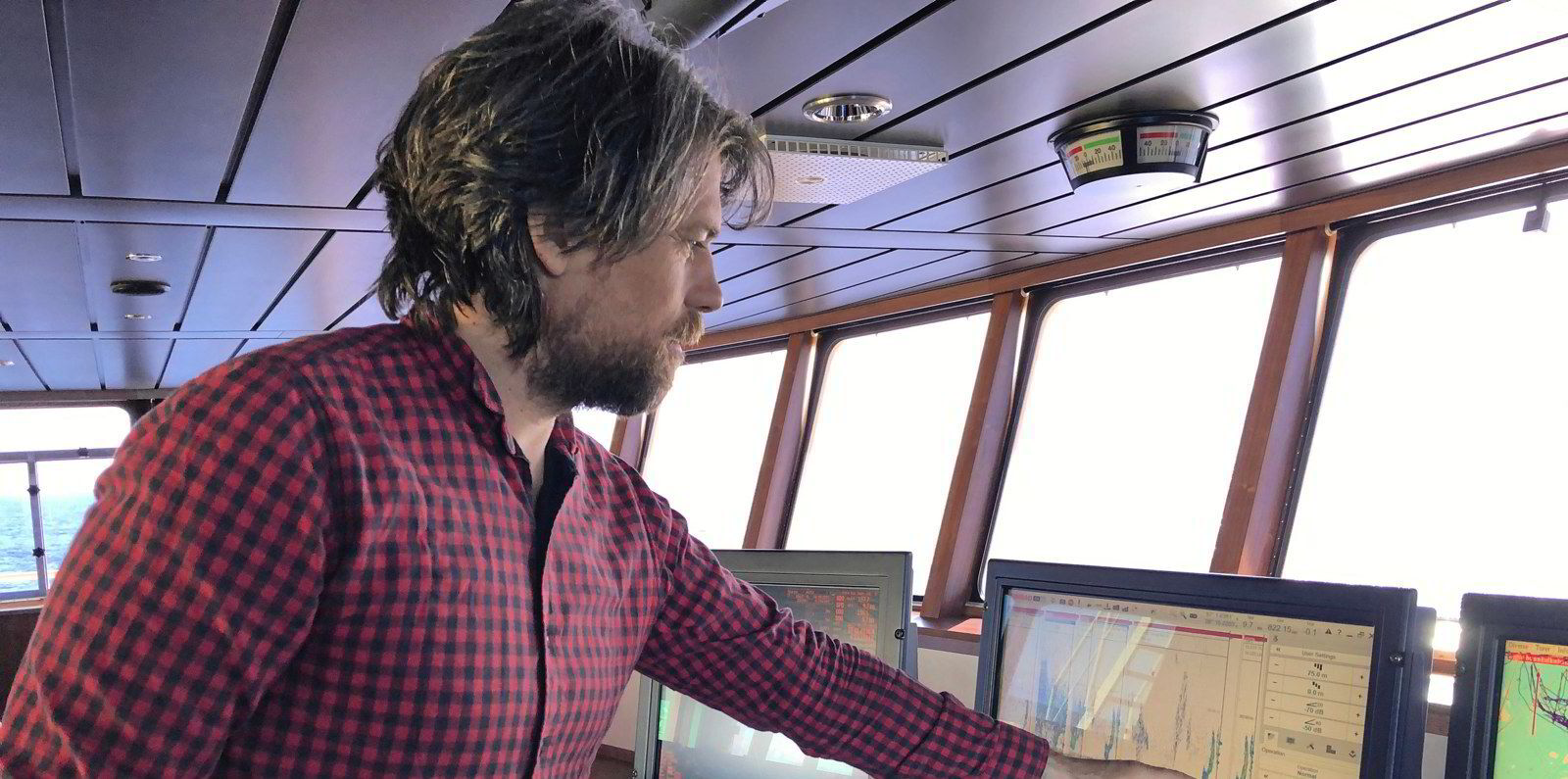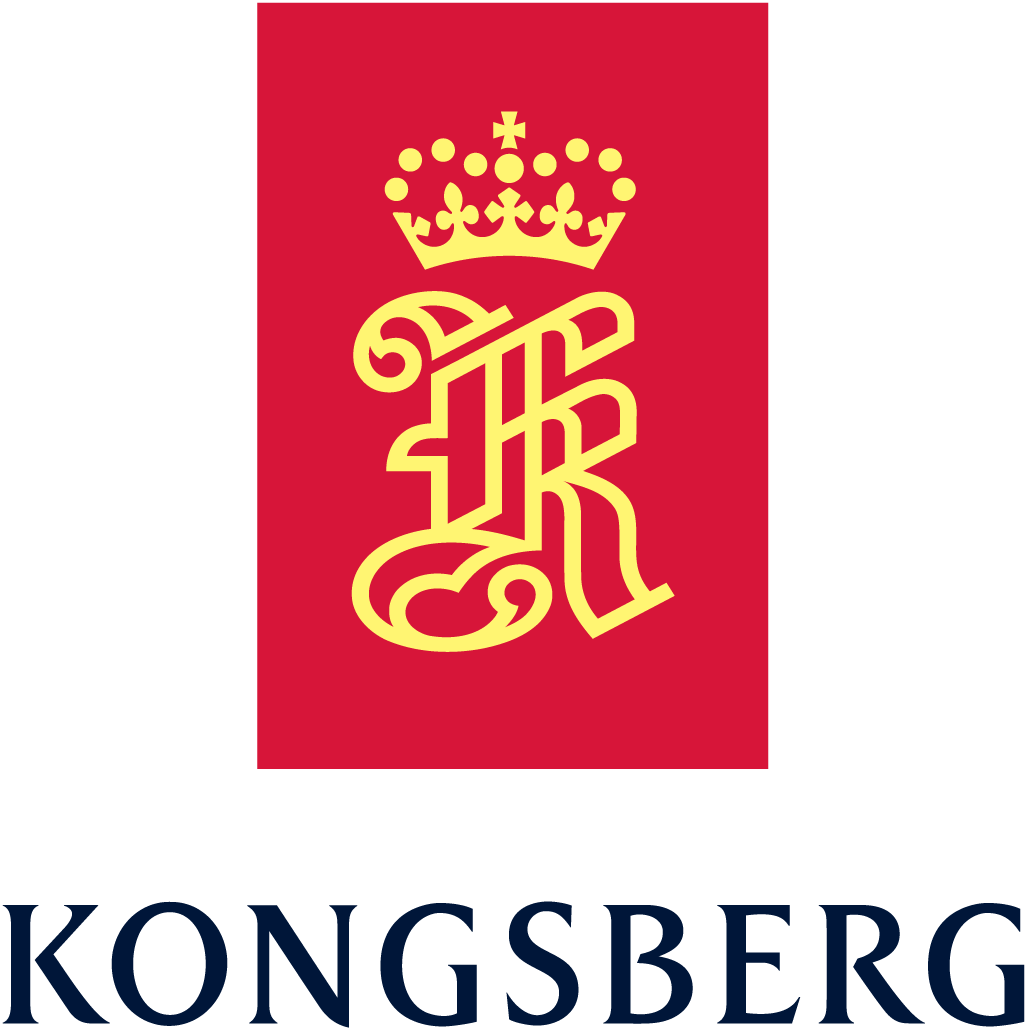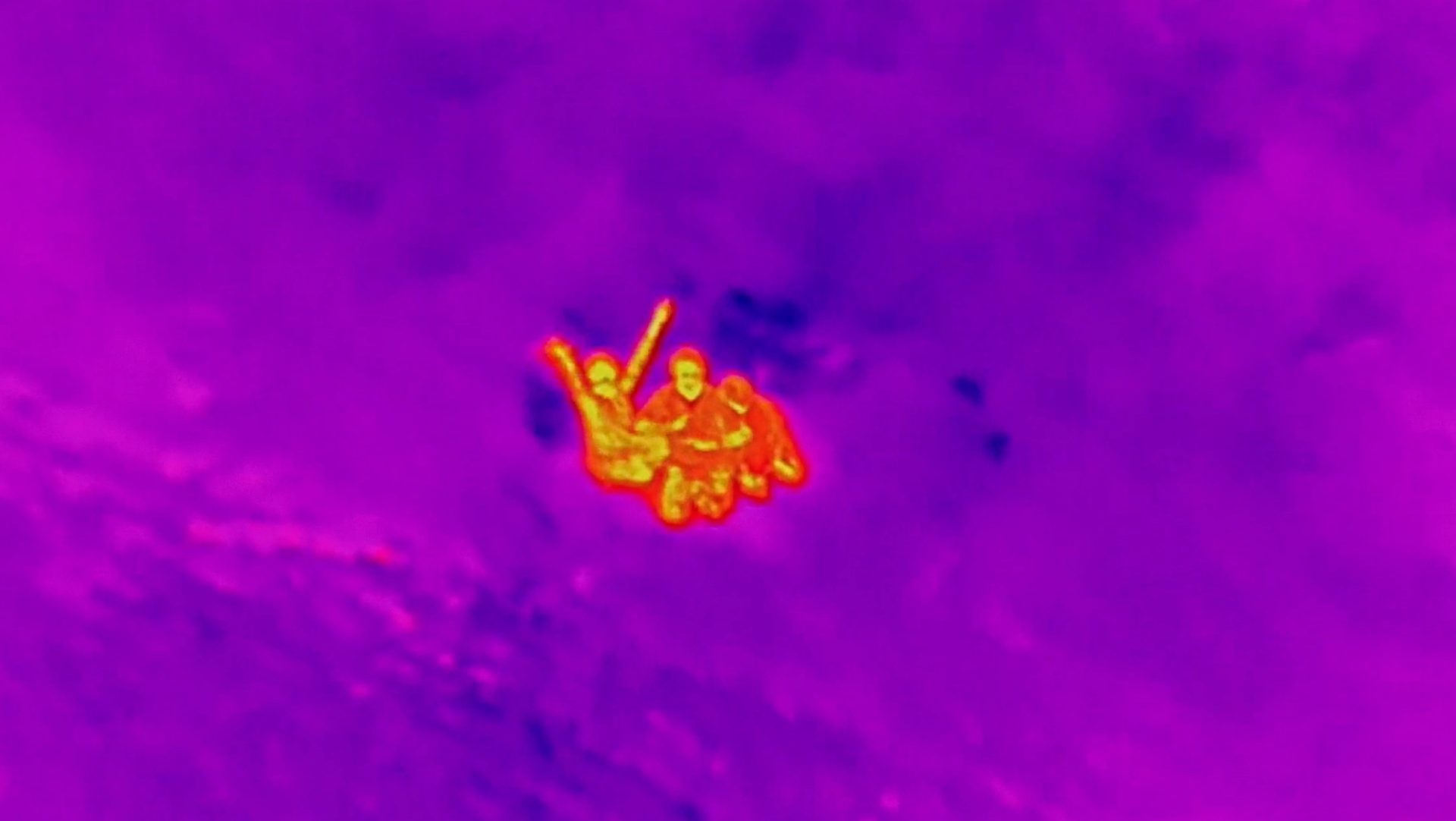
As many as one in five fish may be caught illegally.
As many as one
in five fish may be caught illegally.

Billions of dollars are plundered from the world's oceans every year.
Billions of dollars are plundered from the world's oceans every year.

Kan avansert
teknologi komme oss til unnsetning?
Can advanced technology come to the rescue?
Bycatch from commercial fishing also contributes to depleting fish stocks.
Bycatch from commercial fishing also contributes to depleting fish stocks.
Kongsberg Satellite Services (KSAT) has developed a unique ship-detection technology that could become the biggest nightmare for pirate fishermen.
"All ships at sea today use an automatic tracking system called AIS, which is mandatory for all maritime vessels over 300 tons. The problem with AIS is that vessels can choose to turn the signal off. We then call them a 'dark target'," explains Martin Skedsmo of KSAT.
"Some vessels do this because they are engaged in illegal activities such as weapons smuggling or narcotics trafficking. And then there's a lot of what we call illegal fishing."
The AIS system can be very easily manipulated to send false signals indicating the vessel is not where it actually is. "This practice is called 'spoofing' the signal," Skedsmo says.
The world's most important food source is under attack
Several fish stocks around the world are nearing complete collapse. Organized fisheries crime is a major global problem, and illegal, unreported, and unregulated (IUU) fishing is now the single biggest threat to the world's most important food source.
Over three billion people globally rely on fish and seafood as their main source of nutrition. For the traditional fishing nation of Norway, fish is one of our most important exports. Now, a race against time is underway to save life in the sea.
The eyes in outer space

The UN estimates that between 10 and 26 million tons of fish are caught outside the regulated market every year – equaling between 14 and 33 percent of the global reported catch. Although these estimates may be very uncertain, the numbers are undoubtedly high.
Given that illegal fishing is often linked to narcotics smuggling, human trafficking, money laundering, corruption, and other forms of crime, there are good reasons for serious fishing nations wanting to eliminate this activity.
To succeed, they need the help of the latest technology.
"As marine researchers we need access to as much knowledge about the sea as possible, so technology is extremely important," says Espen Johnsen, Research Director at the Institute of Marine Research in Bergen.
Advanced technology has also become key for daily operations on trawlers and fishing vessels. There is even technology out in space helping to ensure sustainable ocean management.
"Norway is very big in fisheries, not only in terms of marine research but also the associated government apparatus. We are recognized for having perhaps the best water management in the world. With all the critical elements in place we are in a good position to assist other countries with a lot of knowledge, data, and management systems," Johnsen adds.
Martin Skedsmo
Key Account Manager (KSAT)

"Many countries in the world struggle with a significantly weaker state apparatus, where they have to grapple with chronic issues such as corruption, weak surveillance, a dysfunctional coast guard, and a judicial system that can't keep up with crime at sea."
Johnsen has seen this with his own eyes. After completing his Master's degree, he worked in the fisheries sector in Namibia, and has also been involved in projects in Angola and Pakistan.
"Technology is a critical part of the solution – but not the whole solution. It's also critical that there are national systems that can act on the insights that technology provides," he says.
Research Director Espen Johnsen at the Institute of Marine Research in Bergen is deeply engaged in gathering data about our fisheries resources. (Photo: Private)
Journalist: Björn Audunn Blöndal
Foto/video: Björn Audunn Blöndal, Element Envato
Illustrasjon: Marius Halvorsen
To get around this problem, KSAT can combine AIS signals with Synthetic Aperture Radar (SAR) technology that can generate high-resolution images of the sea surface regardless of cloud cover or the dark of night.
"In addition, new satellites can pick up radio signals from vessels' navigation radar and VHF systems. In some cases, we can also pick up signals from satellite phones. By combining the sensor data we can see exactly where ships are, including those that have turned off their AIS."
Every vessel emits a signal with a unique signature, making it possible to create a database of signatures that can reveal ships displaying a suspicious navigation pattern. These are most likely engaged in some form of illegal activity.
Wrong fish in the net
The legal fishing industry is also using technology to operate more sustainably. A massive industry problem is bycatch – animals fishermen don't want, can't sell, or aren't allowed to keep. Bycatch can be the wrong kind of fish or animals like dolphins, whales, sea turtles, and seabirds that get hooked or tangled in fishing gear.
Bycatch is creating major biodiversity problems and even threatening some species with extinction. It also represents an economic loss for fishermen who spend time and resources catching fish species they can't use.
Modern fishing vessels are packed with high-tech equipment. Previously, sonars and echo sounders on board could only observe schools of fish, but today's solutions reveal much more detail: fishermen can see not only what type of fish they are sailing over, but also how big or small they are. They can then avoid hauling up small juvenile fish that can go on to live longer and reproduce.
"Fortunately, fish swim in schools of the same age. If you see on the echo sounder that the fish are too small – or of the wrong type – you can leave them be and look further for the right schools," says Mads Dahl of Kongsberg Discovery, which provides radar, sonar, laser, communication, and positioning technology to the commercial fishing industry and public marine research environments worldwide.
"It's a myth that efficient fishing isn't sustainable. It's the opposite: efficiency is sustainable," he adds. "The faster you can catch your fish, the less emissions (from burning fuel) there will be from your ship. With the right equipment, you catch more of the right fish, with less bycatch. The less you do of what's wrong, with the help of technology, the more efficient and sustainable you are as a fisherman."
"It's a myth that efficient fishing isn't sustainable. It's the opposite: efficiency is sustainable," he adds. "The faster you can catch your fish, the less emissions (from burning fuel) there will be from your ship. With the right equipment, you catch more of the right fish, with less bycatch. The less you do of what's wrong, with the help of technology, the more efficient and sustainable you are as a fisherman."
Modern fishing vessels are packed with high-tech equipment. Previously, sonars and echo sounders on board could only observe schools of fish, but today's solutions reveal much more detail: fishermen can see not only what type of fish they are sailing over, but also how big or small they are. They can then avoid hauling up small juvenile fish that can go on to live longer and reproduce.
"Fortunately, fish swim in schools of the same age. If you see on the echo sounder that the fish are too small – or of the wrong type – you can leave them be and look further for the right schools," says Mads Dahl of Kongsberg Discovery, which provides radar, sonar, laser, communication, and positioning technology to the commercial fishing industry and public marine research environments worldwide.

"It's not the fishermen who are emptying the sea, it's politicians if they don't manage fisheries correctly. The fishermen work to the quotas they're given," says Dahl.
"One prime example is the Atlantic bluefin tuna in the Mediterranean, which almost disappeared in the 1990s due to severe overfishing. A strict quota system was then introduced, and now there are so many Atlantic bluefin tuna that they are starting to put pressure on other fish species," he adds.
Blue insight gathers data
Kongsberg Discovery cooperates with the Institute of Marine Research in Bergen, which is a world leader in fisheries research. Universities all over the world follow them closely.
The company has cooperated with the research establishment since the 1950s, for example by developing solutions and methods for measuring biomass – that is, the quantity of fish in the sea. These measurements are used by relevant authorities to regulate fishing quotas.
A vast amount of data is collected from the sea every day. Thousands of maritime vessels are equipped with a variety of sensors and sonars that continuously gather facts about schools of fish and other marine life. This information becomes even more valuable when consolidated on a platform where it can be analyzed together with other relevant input.
This is the core idea behind the Blue Insight cloud solution.
"We can collect data from both manned and unmanned maritime vessels and upload it to Blue Insight where it can be analyzed and visualized in a web interface," Dahl explains.
Kongsberg Discovery also has permanently mounted equipment that gathers data from structures like bridges and wind farms, or even on the seabed, enabling them to map marine life in defined areas over time.
"For example, when the Great Belt Bridge between Sweden and Denmark was constructed, they used equipment from Kongsberg Discovery to map the effect the bridge had on marine life," says Dahl.

Kongsberg Discovery cooperates with the Institute of Marine Research in Bergen, which is a world leader in fisheries research. Universities all over the world follow them closely.
The company has cooperated with the research establishment since the 1950s, for example by developing solutions and methods for measuring biomass – that is, the quantity of fish in the sea. These measurements are used by relevant authorities to regulate fishing quotas.
"It's not the fishermen who are emptying the sea, it's politicians if they don't manage fisheries correctly. The fishermen work to the quotas they're given," says Dahl.
"One prime example is the Atlantic bluefin tuna in the Mediterranean, which almost disappeared in the 1990s due to severe overfishing. A strict quota system was then introduced, and now there are so many Atlantic bluefin tuna that they are starting to put pressure on other fish species," he adds.
A vast amount of data is collected from the sea every day. Thousands of maritime vessels are equipped with a variety of sensors and sonars that continuously gather facts about schools of fish and other marine life. This information becomes even more valuable when consolidated on a platform where it can be analyzed together with other relevant input.
This is the core idea behind the Blue Insight cloud solution.
"We can collect data from both manned and unmanned maritime vessels and upload it to Blue Insight where it can be analyzed and visualized in a web interface," Dahl explains.
Kongsberg Discovery also has permanently mounted equipment that gathers data from structures like bridges and wind farms, or even on the seabed, enabling them to map marine life in defined areas over time.
"For example, when the Great Belt Bridge between Sweden and Denmark was constructed, they used equipment from Kongsberg Discovery to map the effect the bridge had on marine life," says Dahl.
Blue insight gathers data

Sounder er navnet på én av Kongsberg Gruppens autonome droner - eller såkalte Unmanned surface vehicle (USV). Den kan være ute på sjøen 14 dager i strekk. Den er rigget full av sensorer og utstyr for å samle inn data utrettelig natt og dag.
Autonome fartøy gir oss en unik mulighet til å samle mengder med data på et nivå som aldri har vært mulig tidligere. Aldri før har vi hatt anledning til å bli bedre kjent med livet i havdypet. Dette gir oss et solid underlag til forskere og beslutningstagere verden over.
– Sounder vil kunne gjennomføre et forskningstokt uten mannskap og dekke store områder på et økonomisk og miljømessig bærekraftig vis. Har man flere autonome farkoster, dekker man et større område med svært få ressurser, sier Dahl
'Sounder' is the name of one of Kongsberg Discovery's autonomous marine drones – also known as Unmanned Surface Vehicles (USVs). Packed with sensors and equipment to gather data tirelessly day and night, it can be at sea for as long as two weeks at a time.
Autonomous vessels enable data-gathering on a huge new scale. It's an opportunity to become better acquainted with life in the ocean depths that society has never had before, providing a solid foundation for researchers and decision-makers all over the world.
"Sounder can carry out research voyages with no crew on board and cover large areas in an economically and environmentally sustainable way. If you have several autonomous vessels, you cover a much bigger area with very few resources," Dahl says.

Blue Justice er et norsk initiativ som er igangsatt for å få bukt med ulovlig fiske over hele verden.
– Blue Justice har 61 medlemsland. Alle medlemslandene har til felles at de ønsker å gjøre noe med ulovlig fiske. Dette er land som taper enormt mye penger på at fremmede fiskebåter kommer inn og forsyner seg av deres ressurser og selger det på svartebørsen, sier Skedsmo.
Med skipsdetekteringsdata fra KSAT kan Blue Justice samarbeide med fiskerinasjoner over hele verden om å bekjempe ulovlig fiske. De ulike myndighetene får et svært effektivt verktøy for å avsløre og dokumentere mistenkelig ferdsel og kan vurdere tiltak– som å sende ut overvåkningsfly eller kystvaktskip.
More stories from Kongsberg Gruppen
HISTORIE





